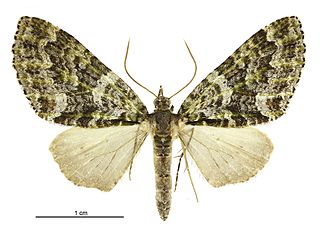
Tatosoma is a genus of moths in the family Geometridae first described by Arthur Gardiner Butler in 1874. The species in this genus are found only in New Zealand.
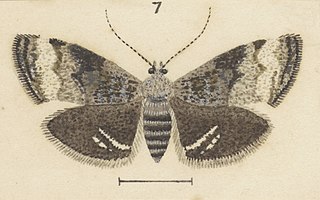
Asterivora albifasciata is a species of moth in the family Choreutidae. It is endemic to New Zealand and has been observed on both the North and South Islands. The adults of this species are on the wing in December and January. Larvae of this species have been raised on Celmisia brevifolia.
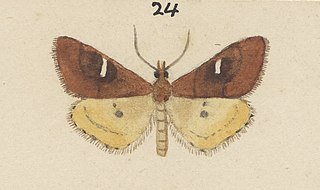
Mnesictena adversa is a moth in the family Crambidae. It was described by Alfred Philpott in 1917 and is endemic to New Zealand.

Sagephora exsanguis is a species of moth in the family Tineidae. It was described by Alfred Philpott in 1918. This species is endemic to New Zealand and has been found on Cuvier Island, as well as the North and South Islands. The adults of this species are on the wing from October to December.
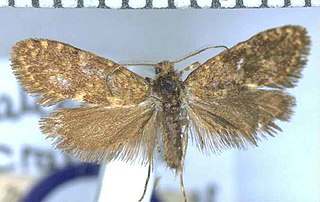
Mallobathra is a genus of moths belonging to the family Psychidae, and are bagworm moths. This genus was first described by Edward Meyrick. It is endemic to New Zealand. The type species of this genus is Mallobathra crataea.

Tingena enodis is a species of moth in the family Oecophoridae. It is endemic to New Zealand and has been collected in and around Nelson. This species can only be reliably distinguished from its close relatives through the different shape of its male genitalia. As at 1939 a female specimen had yet to be assigned to this species.

Tingena seclusa is a species of moth in the family Oecophoridae. It is endemic to New Zealand and has been observed in the Canterbury and Otago regions. The larvae of this species are litter leaf feeders and the adults of this species are on the wing from December to February.

Tingena serena is a species of moth in the family Oecophoridae. It is endemic to New Zealand and has been observed in Southland and Dunedin. The adults of this species are on the wing in December and January.

Tingena terrena is a species of moth in the family Oecophoridae. It is endemic to New Zealand and has been observed in Otago. The adults of this species are on the wing in December.
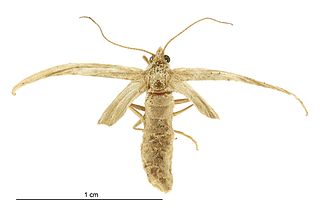
Asaphodes oraria is a species of moth in the family Geometridae. This species is endemic to New Zealand and has been observed in the southern South Island and on Stewart Island / Rakiura. The male is pale yellow coloured and the female has severely reduced wings and is flightless. The habitat of this species is tussock grasslands on coastal sand dunes and in the mountains at elevations of approximately 4,000ft. The larvae have adapted to feeding on exotic lawn daisy species in the genus Bellis. The adults of this species are on the wing from November to April.

Xanthorhoe occulta is a species of moth in the family Geometridae. It is endemic to New Zealand and was first described by Alfred Philpott in 1903. It is found in the North, South and Stewart Islands. The adult moths are on the wing from
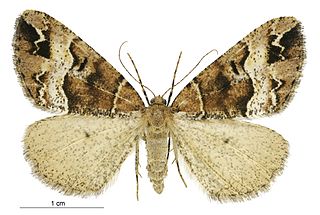
Pseudocoremia fascialata, also known as the Horopito flash, is a species of moth in the family Geometridae. It is endemic to New Zealand.
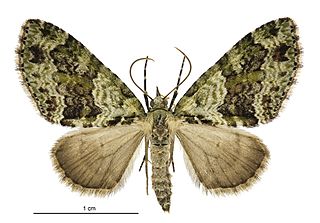
Tatosoma alta is a species of moth in the family Geometridae first described by Alfred Philpott in 1913. It is endemic to New Zealand.
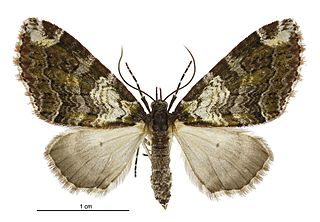
Tatosoma apicipallida is a species of moth in the family Geometridae first described by Louis Beethoven Prout in 1914. It is endemic to New Zealand. The larval host plant of this species is unknown. It has been found from Mount Te Aroha southwards.

Tatosoma fasciata is a species of moth in the family Geometridae first described by Alfred Philpott in 1914. It is endemic to New Zealand. This moth has been observed at Mount Te Aroha, which is possibly the northern most location this species is found. The larval host plant of this species is Lophozonia menziesii.
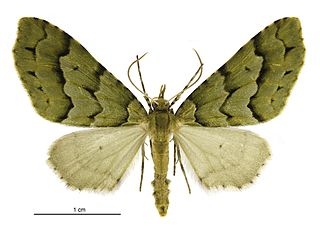
Tatosoma lestevata is a species of moth in the family Geometridae first described by Francies Walker in 1862. It is endemic to New Zealand.
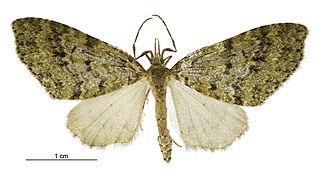
Tatosoma monoviridisata is a species of moth in the family Geometridae first described by Charles E. Clarke in 1920. It is endemic to New Zealand.
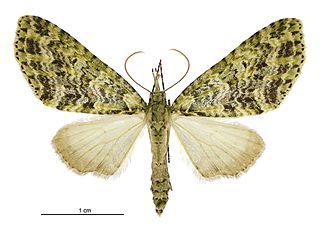
Tatosoma tipulata, also known as the kāmahi green spindle, is a species of moth in the family Geometridae. It was first described by Francis Walker in 1862. It is endemic to New Zealand and occurs in the North, South and Stewart Islands. This species inhabits native bush. The larvae have been recorded as feeding on Pterophylla racemosa, Nothofagus cliffortioides and Podocarpus totara. Adult moths are most commonly observed on the wing from September until March. Adults are nocturnal and are slightly attracted to light. They have also been collected via sugar traps. During the day adults can often be observed resting, camouflaged against moss and lichens, on the trunks of trees.

Scythris nigra is a species of moth in the family Scythrididae first described by Alfred Philpott in 1931. It is endemic to New Zealand. The larvae of this species feeds on Hebe odora. The adults are day flying and on the wing in December.




















